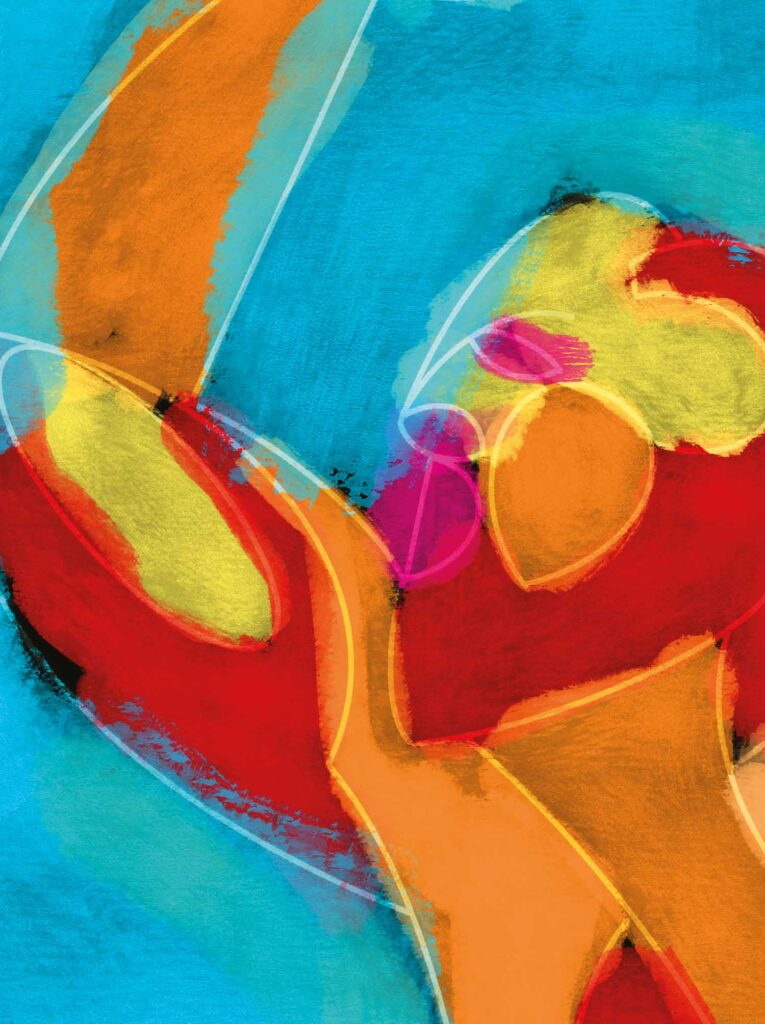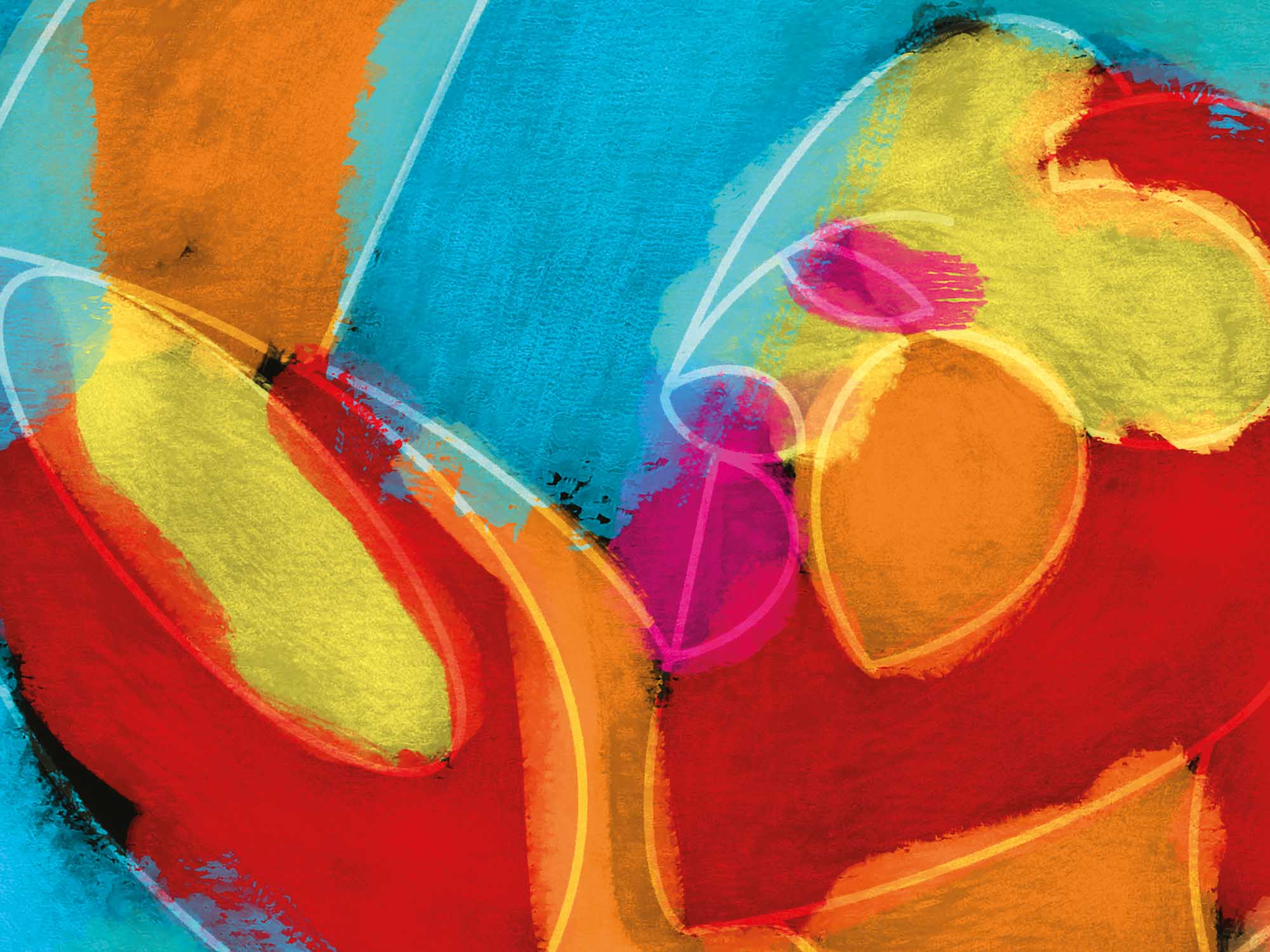Our longing for revelation of the universe culminates on St John’s Day, the only Christian festival of the year named after a person.
For a long time we have longed for summer, for warmth and light, for distance that can become nearness at any moment. It is a longing that shows itself at all levels of our existence—a longing for life in a radiant world, illuminated by sunlight, where we abandon ourselves freely to jubilation. We want to celebrate the world becoming visible. For too long, we waited until the seeds, hidden deep in the earth’s darkness, wanted to give themselves up to visibility. In a summery world, everything—every scent, every gentle breeze, the coolness of a fountain, the light—is like music, a melody that travels across the valleys. Everything becomes a sign of this manifestation.
Above it all arches the canopy of the blue sky by day and the dome of stars by night. The living touches us like a fragrance. It speaks. As we ponder, the magic of everything that sprouts and blossoms manifests in fulfillment. The lyrical and poetic begin to sing within us. For a moment, beauty settles over the world. Our longing has revealed heaven. Delighted, we join in. A wedding is celebrated.
We long for touch in the almost infinite possibilities of encounter. We want to abandon ourselves—to a work of art, to a fellow human being, to an idea or to nature. It is always about the yearning that something like an answer will come to meet us. But we also hope that the longing will inspire us and take us beyond ourselves, to where our destiny awaits.
Touch is mutual: the one who touches and the one who is touched. Sometimes we touch each other as Rilke describes it: “But everything that touches us, you and me, / Takes us together like a bow / Drawing a single voice as from two strings” (From: ‘Love Song’).
A delicate oscillation, a resonance like a hum begins. From these oscillations a constantly expanding experience emerges. The earth has completely exhaled, most strongly in regions where it is midsummer. This is what we abandon ourselves to. As if touched by a world of sounds that draws us along, our listening into the vastness of the heavens grows in intensity until we reach the point where the music of the spheres becomes audible. But who has touched us? Where have we been? What has revealed itself? How far beyond ourselves could that touch lift us? The longing always remains. Because if it had been satisfied, we would only have had a sense of ourselves: “On which instrument are we strung? / And what violinist has us in his hand?” (Rilke, from: ‘Love Song’)

One Crying in the Wilderness
In the Middelheim, an open-air museum of sculpture, there is a bronze sculpture by the Catalan sculptor Pablo Gargallo from 1933. A superhumanly large figure, it stands exposed and alone in a grassy area, a staff in its left hand, its right arm raised in an admonishing gesture, its mouth wide open. It was called ‘The Prophet’ by the artist. He is crying out. The concentrated power of his cry surges up in waves like flames until they contract into a single, warning gesture, as if in a scream. If you approach the sculpture slowly from a distance, observing it from the side, you might notice a double profile: one looking forwards, one apparently looking backwards. Only the forward-facing mouth is open. The profile turned backwards lacks a face although a mouth is just barely implied—a mouth that has already closed.
He wanders in the desert of Judea. “Who art thou?” he is asked. Priests and Levites, sent from Jerusalem, surround him. “I am not the Christ” is his response. Then they ask him: “Art thou Elias? And he saith, I am not.” And he answers “No” when they ask him whether he is the Prophet, for he concludes the series of prophets. At the moment of asking, he is not a witness, not yet. For the one he will point to in recognition is yet to come. What does he say about himself? “I am the voice of one crying in the wilderness” (John 1:19-23, King James Version).
“ἐγὼ φωνὴ βοῶντος ἐν τῇ ἐρήμῳ’” (Phonè boöontes). A voice like a tempest, like a raging, wailing ‘blast’. A wandering voice in the rift between the two greatest possible cosmic periods, between before and after. This too is a desert he has to cross. “Make straight the way of the Lord,” he also says. (εὐθύνατε τὴν ὁδὸν κυρίου)
Anyone who has ever wandered from place to place in a natural desert can experience how each sound makes its way through these regions with unimaginable clarity, sustaining itself. There is no resistance to stop and muffle the sound, except for the swirling grains of sand traveling in the wind. I will never forget the moment when, in the desert of northern Syria at the early Christian monastery ruins near Resafa, a ball of thistles and paper passed by us with a sound like thunder. It was almost weightless and yet it tore the silence apart. Soon it became a dancing, disappearing dot in the blinding sun. It gradually disappeared from our view but remained audible for a long time. The voice of him who cries out in the wilderness also tears the silence apart.
A person who cries out can only call forwards, that is, in front of themselves. So too for John. For the one to whom he will bear witness is in front of him. He is the coming one. He comes from a future that is also the origin. If the coming one were not in front of John, he could not approach him. But what lies behind John is already disappearing, it is dying. The moment is approaching when the cause is to be found in the future. The world, once completely permeated by the light-filled weaving of divine-spiritual creative activity, has emptied. It has become a desert. John’s voice turns to him, the coming one. It is the voice that paves the way for him, the ‘Erchomenos’, to come. In John’s Gospel, this longed-for coming is depicted in just a few simple words. It says: “The next day John seeth Jesus coming unto him.” βλέπει τὸν Ἰησοῦν ἐρχόμενον πρὸς αὐτὸν.
Only now can John bear witness: “Behold the Lamb of God, which taketh away the sin of the world.” ἴδε ὁ ἀμνὸς τοῦ θεοῦ ὁ αἴρων τὴν ἁμαρτίαν τοῦ κόσμου. This is before the baptism in Jordan. Here one human being approaches another human being. John bears witness again, on the day after the baptism: “And looking upon Jesus as he walked, he saith, Behold the Lamb of God!” (John 1:35–36) This time, however, it is no longer Jesus coming towards him, but it is Christ who walks past him. A cosmic age has come to an end — a new one is starting. John has turned around and is looking forward. He knows of the one following him, whose origin lies in the future. At the same time he knows of the first one, born before him: “After me cometh a man which is preferred before me: for he was before me.” (John 1:30) Protos mou èn, wherein the verb ‘èn’ carries the past over into the present: he was and is before me.

‘Eremos’: In an Empty World
The Greek word ‘eremos’ means ‘desert’ but also ‘solitude’. A hermit is someone who has withdrawn into a self-chosen solitude. There are many who retreated into the desert in pre-Christian and post-Christian times. Some as individuals (monachos), others in strictly closed communities. Among these were the Essenes and the Gnostic baptist communities of the Mandaeans, who live to this day in the south of Iraq and see themselves as descendants of John the Baptist. In the first centuries after Christ, the desert around the eastern Mediterranean, especially in Egypt, Palestine, Syria and Iraq, became a place where the first forms of internalisation and following of the Resurrection were practised. This later gave rise to the first monastic orders, from the beginning of the sixth century. It was no longer about self-centred redemption as in the Gnostic schools, but about redemption of fettered nature, within and without, as in the early beginnings of Manichaeism. During these centuries, the desert ‘bloomed’.
Only rarely does a desert bloom. Even more rarely does solitude bloom in the human interior, although it has begun to reveal itself in all of us. Paradoxically we seek out nature as the place where we can rediscover and experience the connection we have lost. In nature we are freed from the solitude that we mostly did not choose, and the burden of this solitude is lifted for a moment.
We find ourselves in a world emptied of that which can no longer reveal itself to our gaze. We encounter the world as that which has come to be, although “this world was once entirely divine-spiritual in being, to which we ourselves also belonged as a part” (Rudolf Steiner, GA 26, 1982, p. 94). We have emancipated ourselves from this belonging, owing to the step-by-step withdrawal of the divine-spiritual creative powers that revealed themselves. Only what has been created, called “the work” by Rudolf Steiner in his Leading Thoughts, remains: “For the human gaze, the divine reveals itself in the forms, in the occurrences of nature, but it is no longer present as something living therein” (Op. cit., p. 96).
“No longer.” How relentless and painful that sounds. Where will this longed-for touch come from if the living no longer comes to meet us in forms? For we owe our self-knowledge to our possibility of standing outside things. We touch them through perception, thinking and feeling from the outside, but we are no longer touched by them. The living part is missing. How and whence can it come today? But Steiner continues: “It is in this sunlike divine, but not living divine world that the human being lives. Into this world devoid of God the human being will carry what is in them, that which their being has become in this age” (Op. cit., p. 96).
It is not the objective world which we, according to our present-day consciousness, encounter as devoid of God that can fill the emptiness with renewed life, but it is that which is in the human being. This life can only flow out of the human being and only from them can it be carried into the place from which the divine-spiritual creative powers have withdrawn. They withdrew; because the emptying is what they intended. The desert must start to blossom again.
God is Dead
We know a curious story about the death of the great god Pan from Plutarch (46 to 119 AD), the philosopher and last priest in the sanctuary of Apollo and the oracle site of Delphi. ‘Pan’ means ‘All’, the omnipresent creative force of nature. He relates that at the time of the Emperor Tiberius (42 BC to 37 AD), the Egyptian helmsman Thamus sailed off the Greek coast on a ship carrying goods and passengers. He heard a voice telling him that when he passed Paxioi he had to announce that the great Pan had died. Thamus hesitated but decided to call out this message when there was a lull in the wind. And thus it happened. He called out: “The great Pan is dead,” and a horrible wailing, mixed with astonishment, echoed from many voices.1
Does this mean that gods are mortal? And when did this twilight of the gods begin? Or does Plutarch’s account, rather, point in the same direction as Rudolf Steiner when he describes the necessary demise of the ancient mysteries? For a Gnostically tinged soul at the time of the Mystery of Golgotha, this would have been an unbearable thought. It took centuries for a part of humanity to dare to think this thought through to the end. Nietzsche’s words about the death of God have lost none of their deeply tragic significance. Tragic also because we are the ones who killed God. No silence breaks the voice of the one crying out in the marketplace, asking, “Whither is God?” and answering himself, “I will tell you, we have killed him.” The voice of the crier dissolves into an oppressive silence. No rebuttal, no answer to his further questions. “Are we not stumbling about as if through infinite nothingness? Does the empty space not breathe upon us? Has it not grown colder?” No lamentation can be heard. “Here the madman was silent and looked again at his listeners: they, too, were silent, and gazed upon him in bewilderment” (Friedrich Nietzsche, ‘The Madman’).
Since then, it has indeed become colder. An age in the aftermath of God has begun. Secularism, as the shaping principle of a communality and culture that we share, was elevated to the norm. Every religion can be reduced to a series of narratives whose relative coherence allows these stories to be replicated, copied, until no verticality emerges any longer. Everything becomes superficial. What remains are fantastical, entrancing stories about the origins of the universe and humans, about the struggle between ancient, titanic forces, about heavenly and subterranean worlds of gods, about magical places and enchanting animals. Peter Sloterdijk calls these narratives ‘theopoetic constructions’.
In his book Making the Heavens Speak: Religion as Poetry, Sloterdijk describes how in ancient high civilisations the power effective in poetry was an originator and presenter of the superior worlds of the gods and therefore occupied a central position. The fearsomeness, the awesomeness of any deity has always been an integral part of such a view. This power gave rise to mythopoetics, in which the narrative wove a meaningful mantle around the core that responded to the enigma of human existence. Rites and religious practices were supposed to bring about the answers. The narrative itself was not the answer. Since then, the woven mantles have grown thin for many among us. We look through them and find ourselves in a world in which each person forms their own mantle woven from ever new narratives. But where is the core or wherein does the creative potency lie? In a society that has taken secularisation as a substitute and classifies questions of meaning as requiring therapy, it is not easy to express one’s longing for the core.
At the end of his book, Sloterdijk speaks of a ‘remnant’. Nowadays, religion is what is left after peeling off everything that was the mantle. What has been skinned finds accommodation in diverse areas that have been endowed by humans as a new environment. Each area stands alone; each has fallen out of the context of the former tapestry. Some fragments reach science, others end up in economics, justice, medicine or media theory, etymology, psychology, ethnology, etc. In the end, all that remains is an undefined piece of terrain. A remnant that is no longer endowed by ‘the poets’.2
Infinite Longing in a Finite World
A “world emptied of God” is not the same as a secular world though both share in the necessity of loss that at the same time opens up new perspectives. The spiritual core and the mythopoetic forces surrounding it, which became colourful, comforting stories, have fallen silent. They have slipped away, lost to us. In an installation, the South African artist James Webb brought the heart sounds of a not-yet-born child into harmony with those of their mother.3 In an otherwise empty room, he hung a microphone on the wall through which visitors could listen to the dialogue of two hearts. He called the artwork Infinite Yearning Met With A Finite World, returning yearning to its place of origin in the heart. The fragmented world is finite—our longing is not. The world is finite, even if vain attempts are made to hide the emptiness from our gaze and to make us believe that every yearning is also finite or relates to the finite.
But those who have been touched, even if only once, are less and less likely to seek an answer or narratives. The touch has turned us around. Did not someone cry out, “Repent ye” (Matthew 3:1)? Since this cry, it is about emptiness, the new core that becomes an unprecedented fullness in itself. This emptiness unlocks our heart. It is a still unknown possibility that we may affirm. Did not the one who cried out say: “There standeth one among you, whom ye know not” (John 1:26)? The desert will bloom again. Already we are touched, delicately. A new way of speaking, a new language yet to be learned has begun.4
Translation Christian von Arnim
Footnotes
- De defectu Oraculorum, Der Tod des Pan, Chapter 17. In: Plutarch, Über Gott und Vorsehung, Dämonen und Weissagung. Religionsphilosophische Schriften. Edited by Konrat Ziegler, Zurich/Stuttgart 1952, p. 126 f.
- In reference to Friedrich Hölderlin’s poem ‘Memento’: “But what remains, the poets endow”.
- James Webb, ‘Infinite Yearning Met With A Finite World‘, Spaces gallery in Cleveland/Ohio, October to November 2018.
- See: Rudolf Steiner, Leitsätze. GA 26, 1982, p. 97.














Dag lieve Christine, je zou me een groot plezier kunnen doen door me jouw oorspronkelijke Nederlandse tekst van dit essaye te willen sturen.
Alle goeds en sterkte, Otto
Dear Christine, loveing best wishes to you from Wales. I would like to read this article. I am retired and living on an UK state pension means I cannot afford to subscribe to the letter.